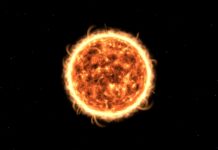The idea of a planet colliding with Earth has captured the imagination of scientists, science fiction writers, and the general public alike. While the prospect is fascinating and potentially catastrophic, such an event is highly unlikely in the near future. Let’s explore the scientific basis for these scenarios, the celestial mechanics involved, and whether humanity needs to worry about a planetary collision.
Celestial Mechanics and Planetary Orbits
The planets in our solar system follow stable, elliptical orbits around the Sun. This stability is maintained by gravitational forces and the vast distances between celestial bodies. For a planetary collision to occur, there would need to be a significant disruption to these orbits, such as the influence of a rogue star, a massive object entering the solar system, or a catastrophic gravitational disturbance.
Such events are incredibly rare, as the solar system has been relatively stable for billions of years. However, there are theoretical possibilities worth examining.
Hypothetical Scenarios for Planetary Collisions
- The Nemesis Hypothesis
Some scientists have speculated about the existence of a distant, dim companion star to the Sun, dubbed “Nemesis.” If such a star exists and its orbit brings it close to the solar system, its gravitational pull could disrupt the orbits of planets and asteroids, potentially sending them toward Earth. However, no evidence for Nemesis has been found. - Planet Nine
Astronomers have hypothesized a ninth planet beyond Neptune, based on irregularities in the orbits of distant objects in the Kuiper Belt. If Planet Nine exists, its trajectory is far beyond Earth’s orbit, making a direct collision improbable. However, it could indirectly influence Earth by disturbing the orbits of comets or asteroids. - Rogue Planets
Rogue planets, or planets that have been ejected from their home systems, wander through space without orbiting a star. If a rogue planet were to pass through our solar system, its gravitational forces could disrupt planetary orbits, potentially creating conditions for a collision. Fortunately, such encounters are exceedingly rare. - Asteroid and Comet Threats
While full-sized planets are unlikely to collide with Earth, smaller objects like asteroids and comets pose a more immediate threat. These collisions, though devastating on a local or global scale, are not as catastrophic as a planetary impact. Ongoing monitoring programs like NASA’s Planetary Defense Coordination Office work to identify and track potentially hazardous objects.
Mitigating the Risks
Scientists are actively studying ways to deflect or mitigate celestial threats, such as asteroids or comets, through missions like NASA’s DART (Double Asteroid Redirection Test). For larger-scale threats like rogue planets, humanity’s options would be limited, emphasizing the importance of advancing space exploration and potentially establishing off-world colonies as a safeguard.
A Reassuring Conclusion
While the concept of a planetary collision is thrilling and often dramatized in movies and books, the reality is that such an event is extremely unlikely in the foreseeable future. The stability of our solar system and the vastness of space work in Earth’s favor.
For now, our focus should remain on protecting the planet from smaller, more immediate celestial threats and continuing to expand our understanding of the cosmos. After all, knowledge is our greatest defense against the unknown.
Earth, though vast and resilient, exists in a cosmic environment filled with potential dangers. Among these threats, asteroids, comets, and hypothetical rogue planets represent some of the most significant challenges. While planetary collisions are incredibly rare, the risk of smaller celestial bodies impacting Earth is more immediate. This is where the science and strategy of planetary defense come into play.
The Real Threat: Asteroids and Comets
Unlike planets, asteroids and comets frequently pass close to Earth. These Near-Earth Objects (NEOs) range in size from a few meters to several kilometers in diameter. Impacts from large NEOs can cause massive destruction, as evidenced by past events:
- The Chicxulub Impact (66 million years ago): A 10-kilometer asteroid struck the Yucatán Peninsula, leading to the extinction of the dinosaurs and reshaping Earth’s climate.
- The Tunguska Event (1908): An explosion over Siberia, likely caused by a smaller asteroid or comet fragment, flattened over 2,000 square kilometers of forest.
Such incidents highlight the importance of tracking and mitigating these threats.
Monitoring the Skies: Early Detection Systems
Several organizations work to identify and monitor NEOs, including:
- NASA’s Planetary Defense Coordination Office (PDCO): This agency oversees efforts to detect, track, and mitigate potentially hazardous objects.
- ESA’s Space Safety Programme: The European Space Agency conducts similar work, developing missions like the Hera spacecraft to study asteroid deflection.
- Pan-STARRS and NEOWISE Telescopes: Ground- and space-based observatories scan the skies to catalog NEOs and predict their trajectories.
As of now, scientists have cataloged over 30,000 NEOs, with a small percentage classified as potentially hazardous.
Deflection Strategies: Redirecting the Danger
- Kinetic Impact
NASA’s DART mission successfully demonstrated this method in 2022. The spacecraft collided with the asteroid Dimorphos, altering its orbit. This approach could redirect an asteroid away from Earth if sufficient warning time is available. - Gravity Tractor
A spacecraft could hover near an asteroid, using its gravitational pull to gradually alter the object’s trajectory. While slow, this method is precise and avoids fragmentation. - Nuclear Deflection
A last-resort measure, nuclear explosions near an asteroid could push it off course. Unlike cinematic portrayals, this would involve detonating the device beside the asteroid, not on it, to avoid creating multiple hazardous fragments. - Laser Ablation
Lasers could be used to heat the surface of an asteroid, causing material to vaporize and produce a thrust effect. Though still theoretical, this method offers a non-invasive approach to deflection.
The Role of International Collaboration
Given the global nature of celestial threats, planetary defense requires international cooperation. Organizations like the United Nations’ Committee on the Peaceful Uses of Outer Space (COPUOS) facilitate discussions on how to respond to NEO risks collectively.
The Future of Planetary Defense
Advances in technology and collaboration are improving our ability to protect Earth. Future missions, such as NASA’s NEO Surveyor space telescope, aim to increase detection capabilities. Efforts to mine asteroids for resources may also contribute to planetary defense, as understanding these objects’ compositions is crucial for deflection strategies.
Staying Vigilant
While the likelihood of a catastrophic impact in our lifetime is small, the consequences could be devastating. Continued investment in detection, technology, and international cooperation ensures that humanity is prepared for these celestial challenges. Planetary defense is not just a scientific endeavor—it is a testament to our ability to safeguard the future of life on Earth.
 Photo by David Menidrey on Unsplash
Photo by David Menidrey on Unsplash
Views: 6






